► Mazda E-6 tweaked for Europe
► Coming to the EU soon, UK closer to 2026
► Two EV powertrains only for now
You’re looking at the Mazda 6e, a new electric car from the Japanese brand and its second full EV after the MX-30. The only catch? It’s actually a hatchback rather than saloon – and it’s not produced by Mazda, either.
The 6e might look familiar and that’s because it’s pretty much identical to the Changan co-developed Mazda EZ-6, a car that impressed when it was unveiled at last year’s Beijing auto show. Now, after a few tweaks, it’s primed for release in Europe – and eventually the UK.
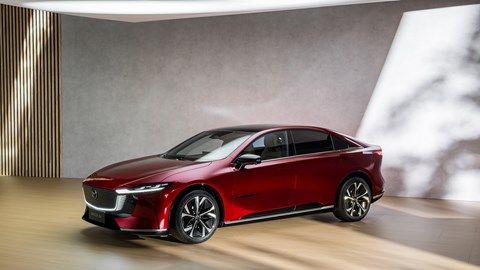
Keep reading for everything you need to know about the Mazda 6e.
What is it?
The Mazda 6e is a very different car to the MX-30: it leans not on Mazda’s own R&D resources (which will still develop EVs) but Changan, another Chinese giant not yet in Europe. The reasons for partnering were clear for Mazda Europe’s manager of technology research and technology communication, Uwe Mandal:
‘The advanced technology, battery technology, also the raw materials, the expertise and the capacity are located in China,’ Mandal tells CAR. ‘So, for us it was a good partnership with Changan.’
With that in mind, Mazda’s priority was ensuring the 6e looked like the part – despite its third-party internals: ‘When you look at it now, you can see that it’s really carries the Mazda DNA, the flavour that we usually bring to the market with our purely self-developed vehicles,’ he says.
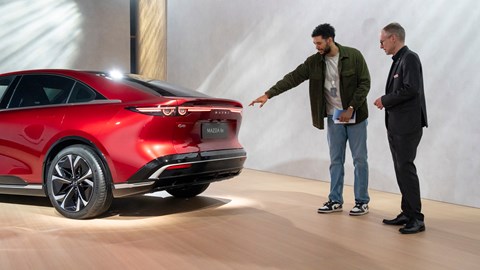
I’d agree. In person the 6e is just as striking as Mazda’s other products; it’s a concoction of intricate details, billowing curves and scalloped recesses – the same styling we’re using to seeing in other segments in cars like the CX-30, but on the more elegant canvas of a saloon. The 6e even benefits from a riff on the brand’s classic round rear lights.
Measuring 4921mm long, 2156mm wide and 1461mm high, it’s not small but offers even more space than you’d expect. The 6e also very raked and begins with a low sharp front end, before ending in a high, spacious rear. A spoiler at the rear of the car also opens and closes depending on the speed you’re going.
Despite its somewhat athletic looks, there’s a good amount of both head and leg room – even for someone over 6ft – and there’s a 330-litre boot at the rear (which extends to 1074-litres with the seats down). Mazda’s decision to make the 6e hatchback was largely led by internal targets for passenger space and storage.

The company is open about some of the styling decisions on the 6e: the new car gets a simple typeface on the rear rather than a badge, because Mazda admits its current logo simply doesn’t have the brand recognition and traction with the car-buying public.
The EZ-6’s garish fully-illuminated grille has been lost in translation; only the grille surround lights up on the 6e – and it moves when charging. ‘Chinese customers are more used to expressive signalling and blinking lights,’ Mandal explains to us of the change. ‘But here we want to embody a different design language, one more in line with our Japanese aesthetic approach.’
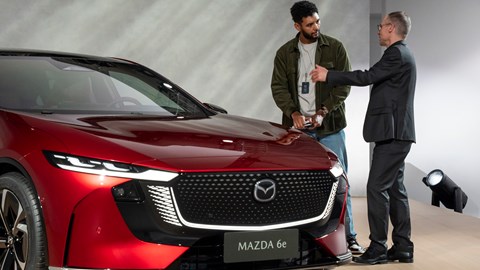
Other tweaks include sharpened dynamics over the Chinese car: ‘The key is that the vehicle performs as a true Mazda in the European market, to meet European drive expectations,’ he continues. ‘For a nimble drive, for handling, for that typical Mazda feeling. I think in other regions, it’s not as much the focus of customers.’
What are the specs?
Unlike the Mazda EZ-6 which is available with REX and pure BEV powertrains, the 6e will launch as a pure EV only. ‘At the moment, we don’t plan [a REX],’ Mandal says, before citing the lengthy process of engineering around emission regulations. ‘We’re stepping into full electrification with this vehicle,’ he says. ‘When you have such powertrain [like the REX] available, I would never say never – but it’s not planned.’
To that end, you only get two powertrain choices with the 6e; a big 68.8kWh battery and a bigger 80kWh battery in the long-range car. The smaller battery offers a range of 298 miles and is paired to a 190kW (255bhp) electric motor which sends 236lb ft to the rear axle. That’s good for 0-62mph in just 7.6 seconds, and a top speed of 109mph. Charging from 10% to 80% can take just 22 minutes.
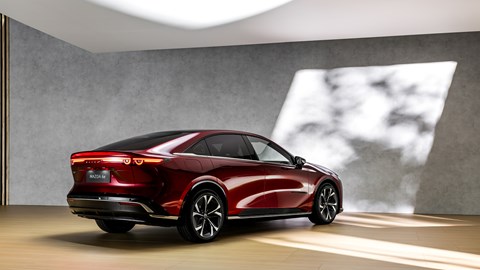
The long range, 80kWh car gets a range of 343 miles, and its 180kW (241bhp) electric motor delivers 236lb ft to the rear axle too. It’s slightly slower to 62mph at 7.8 seconds but has the same top speed of 109mph.
Those figures are literally miles away from the paltry MX-30’s, but the Mazda man says this is due to the 6e’s differing use case – not an overall change in EV strategy: ‘The MX-30 was planned as a second car in the household, with more focus on the daily chores,’ he said. ‘The 6e has to be like a main car, a true family car that can go on a holiday or long trip.’
What about inside?
Inside the 6e is a lot techier than the rest of the range, with a huge 14.6-inch touchscreen on the centre stack and a further 10.2-inch digital instrument for the cockpit. On top of that, Mazda has also introduced a head up display which is equivalent to a 50-inch TV when viewed 7.5 metres away (the typical distance a driver is looking ahead).
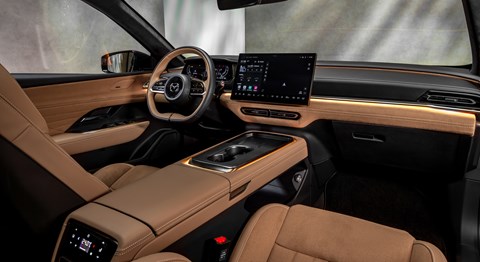
Hand gestures and voice control are also present and new for Mazda, along with a Sony-badged 14-speaker audio system. You’ll find beige or black artificial leather in the standard Takumi package, though that improves to the Tan Nappa and Suede leather in the Takumi Plus.
Opt for the latter and you also get an electric sunshade trim instead of the standard tinted panoramic sunroof.
When it’s coming out?
The 6e is already in production and will arrive in dealer showrooms in summer this year. The UK will have to wait for a few months for the RHD version, so UK consumers are looking at 2026 for delivery.
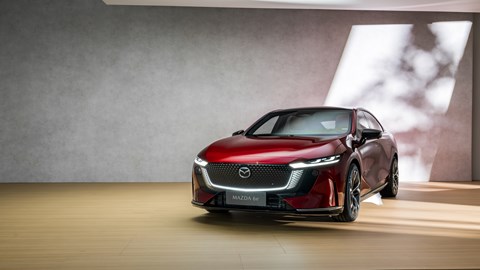
When order books do open, Mazda believes it’ll be bringing in existing 6 owners as well as fleet managers looking for a high-quality, zero emissions solution: ‘The car clearly going to be really important in fleet,’ a Mazda UK spokesperson told CAR. ‘But also, our dealers are very excited by this car, because there’ll be lots of existing Mazda customers that haven’t made the step to an EV yet.’